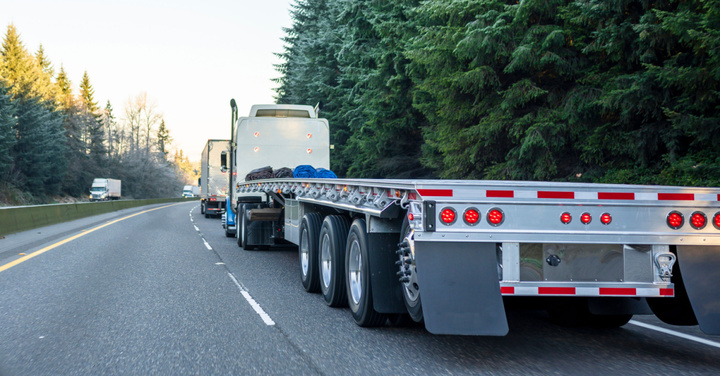Flatbed shipping is consistently growing with the high demand for consumer goods, but it presents challenges along with its benefits. Like all things with unique challenges, there are best practices and ways to manage the process for greater success.
Many flatbed freight shipping challenges, such as weather or road conditions, are beyond anyone’s control. Other logistical challenges, like scheduling and finding freight companies, can change based on the season. Needless to say, flatbed shipping comes with some complexity, but we’re here to help you learn how to manage your flatbed needs.
What Is a Flatbed Truck?
A flatbed truck has no sides or roof over a flat body. If a load is heavy, wide, and not compromised by weather or bad roads, it’s perfect freight for a flatbed.
Flatbeds are quickly loaded and unloaded with equipment like forklifts or cranes, making them very efficient forms of shipping.
What are the Types of Flatbed Trucks?
Flatbed trucks come in many different styles and sizes to accommodate specific uses and cargo types.
Flatbed
The traditional flatbed truck is easy to use and can be loaded from any angle. This truck is perfect for abnormally sized and shaped freight, and its maximum weight and dimensions are:
- Freight weight: 48,000 pounds
- Width: 8 feet 6 inches
- Height: 8 feet 6 inches
Step deck
Step deck trailers, often referred to as drop deck trailers, have bottom and top decks. A step deck is used when cargo is too tall or wide to fit onto a standard flatbed. Extra tall loads will be able to clear low bridges due to riding much lower. The maximum weight and dimensions are:
- Max freight weight: 48,000 pounds
- Bottom deck length: 37 feet
- Top deck length: 11 feet
- Width: 8 feet 6 inches
- Bottom deck height: 10 feet
Extendable flatbeds
Extendable flatbeds are sometimes referred to as flatbed stretch trailers. As either name suggests, these trailers are extendable for cargo too long to haul on a traditional flatbed. This trailer type is used when overhang is not acceptable, and sometimes these loads require escort vehicles and special permitting. The maximum weight and dimensions are:
- Maximum freight weight: 43,000 pounds
- Minimum length: 48 feet
- Maximum length: 80 feet
- Width: 8 feet 6 inches
- Height: 8 feet 6 inches
Stretch Single-Drop Deck
Combine a drop deck and an extendable flatbed, and you have a stretch single-drop deck that can legally carry loads a regular drop deck cannot. Attaching a bulkhead to the front of the trailer is an option to protect the freight in hard-breaking situations and better secure loads. The maximum legal weight and dimensions are:
- Maximum freight weight: 45,000 pounds
- Main deck minimum length: 35 feet
- Main deck maximum length: 63 feet
- Width: 8 feet 6 inches
- Height: 10 feet
- Front deck length: 10 feet
Double drop
A double drop trailer is made for oversize freight and can handle items over 10 feet tall. Typically, the cargo hauled by this trailer is loaded and unloaded by a crane. The dimensions and maximum weight are:
- Maximum freight weight: 36,000 to 42,000 pounds
- Main deck length: 25 feet to 29 feet
- Main deck width: 8 feet 6 inches
- Main deck height: 11 feet 6 inches
- Front deck length: 10 feet
- Front deck width: 8 feet 6 inches
- Front deck height: 8 feet 6 inches
- Rear deck length: 9 feet
- Rear deck width: 8 feet 6 inches
- Rear deck height: 10 feet
Removable gooseneck trailer (RGN)
RGNs are versatile trailers used for tall and long loads. Detaching the trailer lets it drop to the ground, turning the front into a ramp that makes it possible to drive heavy machinery onto the trailer. Additionally, these trailers sport from three to as many as 20 axles, enabling the hauling of impressive payloads. The maximum weight and dimensions are:
- Maximum freight weight: 42,000 pounds
- Main deck length: 29 feet
- Main deck width: 8 feet 6 inches
- Main deck height: 11 feet 6 inches
- Front deck length: 10 feet
- Front deck width: 8 feet 6 inches
- Front deck height: 8 feet 6 inches
- Rear deck length: 9 feet
- Rear deck width: 8 feet 6 inches
- Rear deck height: 10 feet
Side-kit trailers
Side-kits have panels around the bed’s perimeter for a structure that allows for attaching tarps to protect cargo. The dimensions and weight limit are:
- Maximum freight weight: 45,000 pounds
- Length: 48 or 53 feet
- Width: 8 feet 4 inches
- Height: 8 feet 6 inches
Lowboys
A lowboy trailer is appropriate if the cargo is too high for even a step deck. While it resembles a step deck, it sits even lower. At only 18 inches off the ground, freight up to 11 feet 6 inches can be accommodated.
What Ships on Flatbed Trucks?
Flatbed freight trucks carry a wide variety of freight, from large equipment to raw materials. If it’s a large, heavy load, a flatbed truck is probably carrying it.
Some common freight moved by flatbed hauling services include:
- Building materials, like lumber, iron and steel bars, concrete slabs, and scaffolding
- Farm equipment like combines and tractors
- Large industrial machinery
- Drilling and mining equipment
- Defense equipment, like tanks and troop transports
What Is the Cost of Flatbed Shipping?
A lot comes into play when tabulating flatbed rates. Factors like distance, weight, and size are all considerations.
What are the Average Rates?
Flatbed rates in the US are around $3.00 per mile as of late 2022. Prices vary by region, sometimes by a few cents and other times substantially.
To give you an idea of how rates vary, here are the average rates by region.
| Region | Price per mile |
| Northeast | $2.76 |
| Southeast | $2.89 |
| Northern Midwest | $3.05 |
| Lower Midwest | $2.88 |
| West | $2.47 |
It’s important to remember that these averages can fluctuate by state, carrier, and current events.
The trip mileage will fall into one of eight shipping zones when shipping your freight. Calculating your cost will be as simple as multiplying the miles the cargo will travel by the per-mile rate. The shipping zone mileage standards are:
- Zone 1: 0-50 miles
- Zone 2: 51-150 miles
- Zone 3: 151-300 miles
- Zone 4: 301-600 miles
- Zone 5: 601-1,000 miles
- Zone 6: 1,001-1,400 miles
- Zone 7: 1,401-1,800 miles
- Zone 8: 1,801 miles or more
Factors that determine your shipping rates
The weight of your freight, current fuel costs, destination, and cargo restrictions will impact your flatbed shipping quotes.
The weight and fuel costs
The most significant determinant of the flatbed quote is the weight of the cargo. Heavy freight requires specialized trailers and chassis, increasing the cost of your flatbed shipping quotes.
Additionally, the heavier the freight, the more fuel it burns to haul it. The more fuel used and fluctuating diesel prices will often result in the carrier having to charge more to cover their expenses.
Destination
When moving huge freight, specific routes might not be usable. If the freight can’t be hauled under an overpass or bridge, an alternate route will be required and could be significantly longer. Adding miles to your route will result in a more significant expense.
How do you calculate the flatbed shipping costs?
Getting an exact calculation of your shipping cost is difficult due to the variability that can come into play. A reasonable estimate is as easy as multiplying the total distance by the average regional shipping cost.
If your freight needs to travel 250 miles through the west, using the averages given above, the equation is 250 * $2.47 = $617.50.
What are the Challenges of Flatbed Shipping?
Flatbed truck shipping presents considerable challenges, primarily due to the variation in cargo. The different shapes, sizes, and weights make every load unique.
Some of the biggest challenges of flatbed shipping include:
- Loading: Proper loading of cargo is critical. It has to be balanced and accurate or hauling it becomes a challenge and a safety risk. When each load is tremendously different, the equation is different every time.
- Securing: Securing cargo can’t be a guessing game and requires great skill. The Department of Transportation (DOT) regulates even the tie-downs used. Improperly secured freight is a safety issue and a threat to the cargo.
- Tarping: Drivers must be skilled in tarping to ensure tarps are appropriately secured. A loose tarp might fly into other vehicles and cause a traumatic accident.
- Regulations: Because of the sizes and types of loads often carried by flatbeds, regulations are stringent. Drivers must balance and secure freight properly and know load limits and trailer sizes.
4 Best Practices for Flatbed Shipping
Like all logistics management, it pays to know the best practices to ensure your freight moves smoothly, preventing or minimizing business disruptions. Here are a few of the most important.
1. Monitor the Market
Market conditions, economic or freight, tremendously impact shipping management. Shifting demands for specific products will affect trailer availability and increase or reduce prices for flatbed truck shipping. If goods that require a specific trailer are in high demand, plan on spending much more time finding a freight flatbed service with the capacity for your freight.
2. Utilize the Best tools & Tech
Robust software is crucial for efficiently managing your freight. Technology measures and improves performance in real-time, digitizes route planning, simulates market conditions, and provides freight visibility. Excellent technology offers the knowledge to move your freight quickly and at the best rates.
3. Be Aware of Your Procurement Policies
While monitoring market trends, you’ll notice constant and unpredictable changes. As markets shift, keeping your procurement flexible is a no-brainer. Annual bids support that flexibility, and quarterly procurement reviews help you keep up with seasonal shifts.
Use your procurement knowledge to shop carriers, looking for those offering discounts or increased capacity in certain seasons. Planning streamlines your company’s ability to adapt to changes and get some great deals.
4. Have a Great Partner
If you want to take all of the prior concerns and best practices off your plate, using a third-party logistics provider (3PL) is the solution. Your 3PL partner will sweat the details to ensure you get the best rates, have your freight hauled by the best providers, constantly monitor the market, and enhance your company’s efficiency.
Choose AMX Trucking for Your Flatbed Shipping Needs
As a 3PL that transports tens of thousands of shipments yearly, AMX has the experience to effectively and efficiently manage your flatbed shipping needs. Thirty years of industry experience have resulted in a diverse carrier base to complement AMX’s award-winning fleet and meet every hauling need.
AMX uses the latest technology for complete freight visibility and data sharing, so you’ll always know where your freight is and what to plan for on the receiving end.
Whether your company’s needs are contract, bulk, or spot, your AMX expert provides individualized support to get your freight safely to where it needs to go at the best price.
Using AMX removes all headaches from flatbed shipping and delivers superior results.
It’s Time to Experience Simplified Flatbed Shipping
Flatbed shipping has a lot of serious considerations and variations that can make it a complex endeavor. There are ways to improve your flatbed shipping success and minimize disruptions, but the best results will always come through an experienced 3PL partner.
Reach out to AMX Trucking today, and we will show you how we can bring flatbed shipping success to your company.


